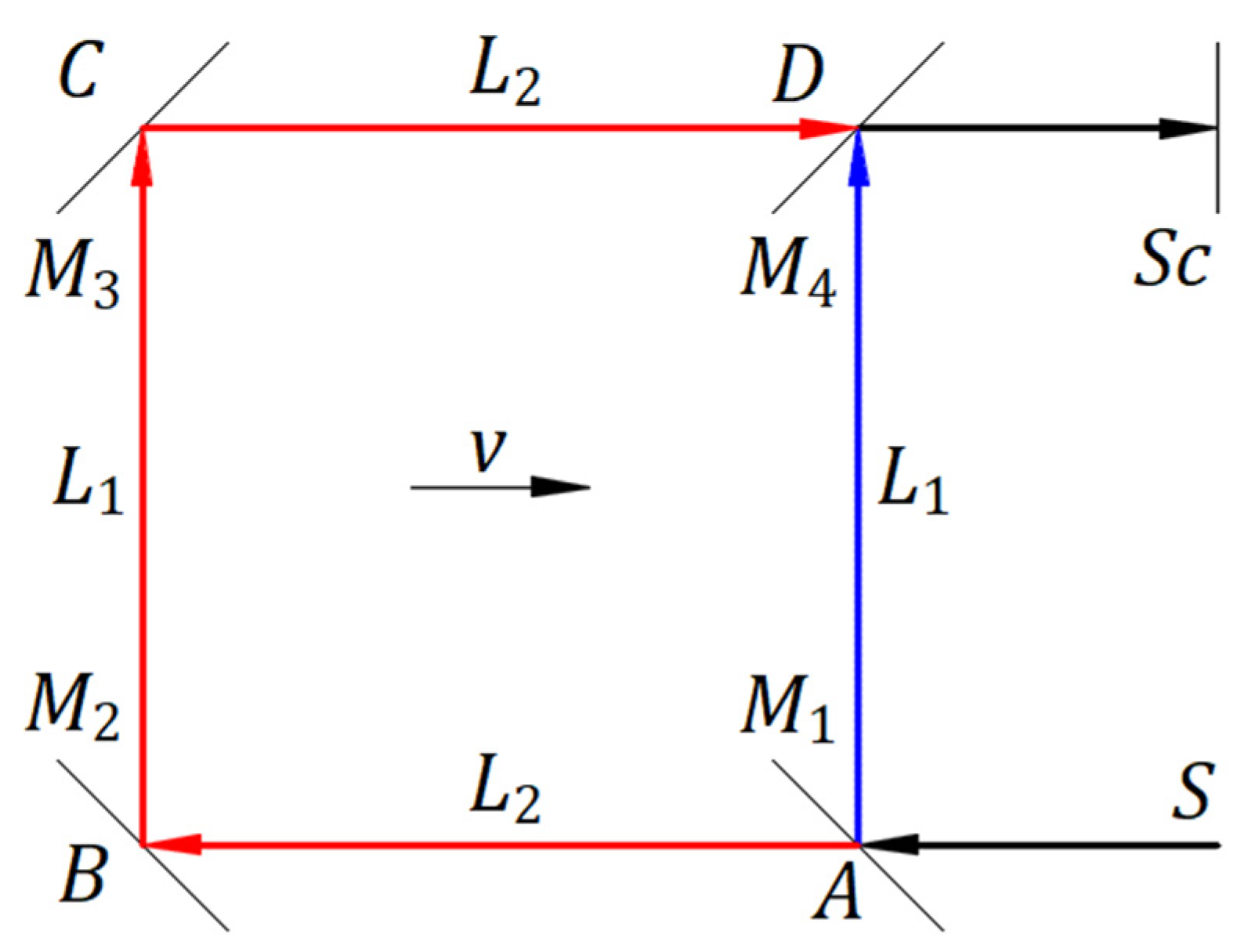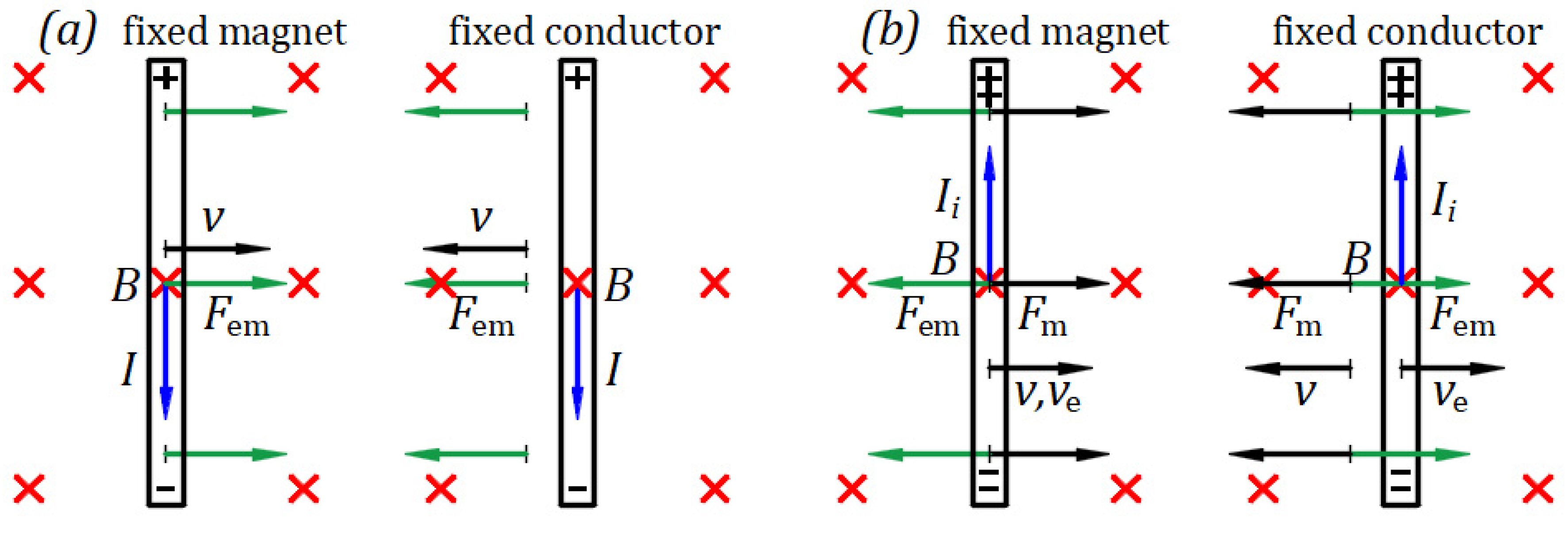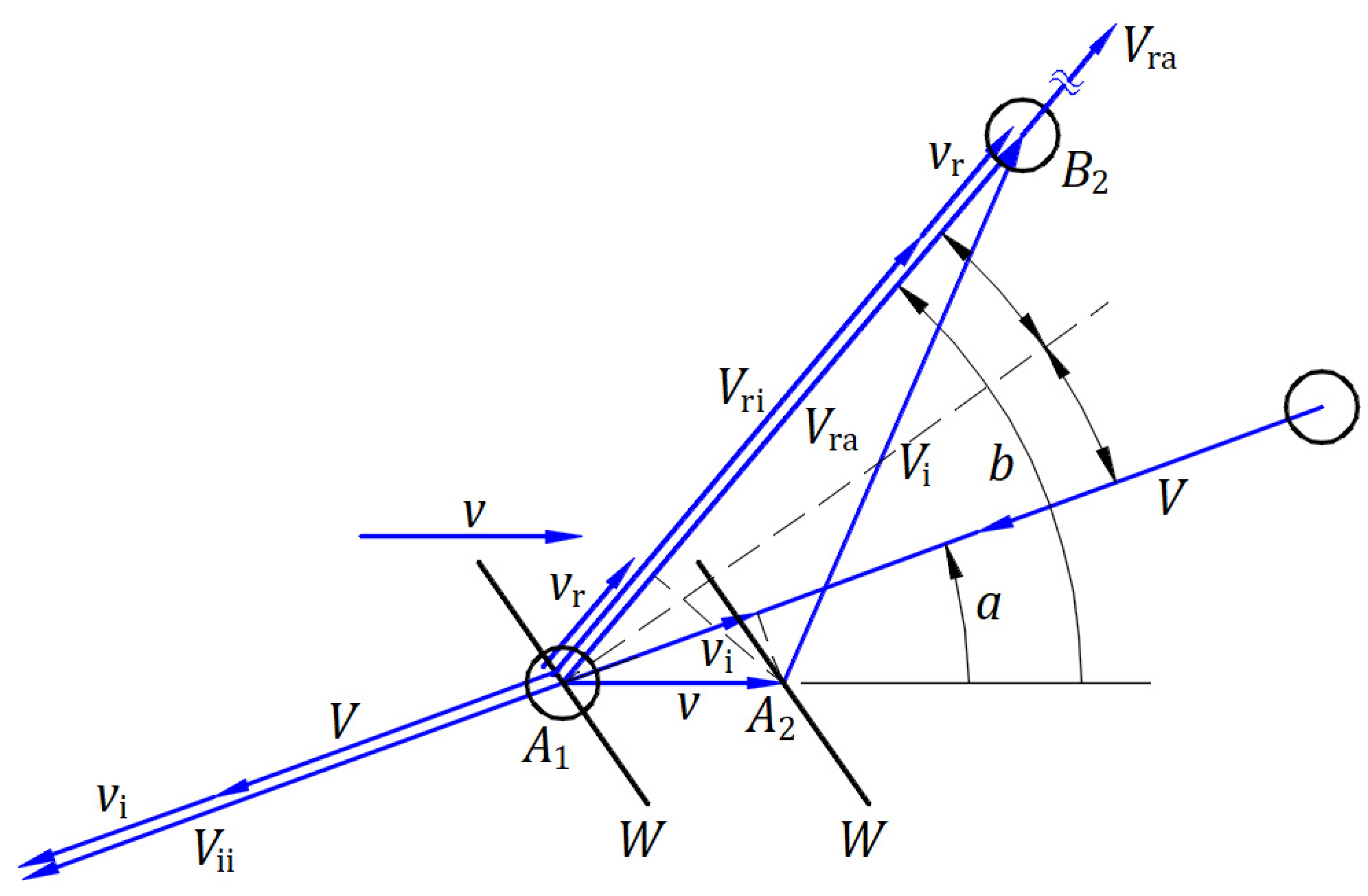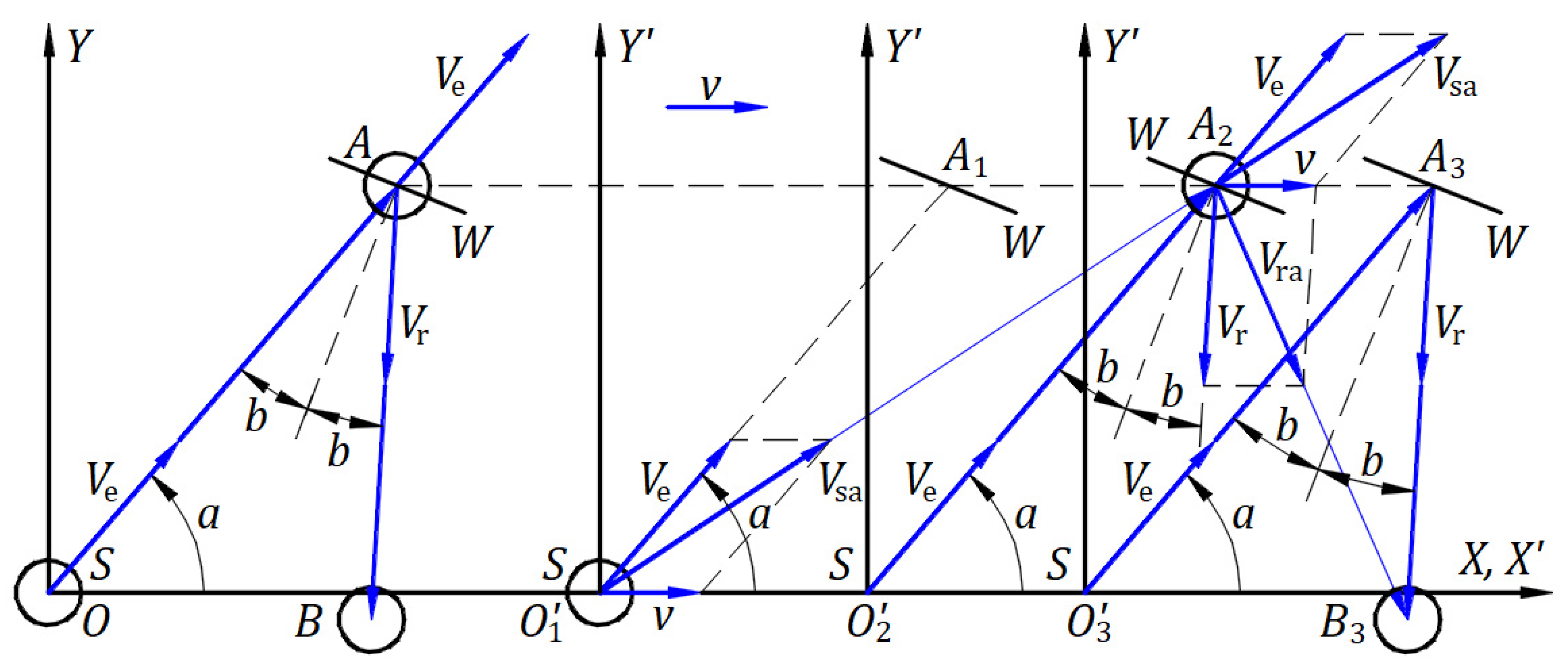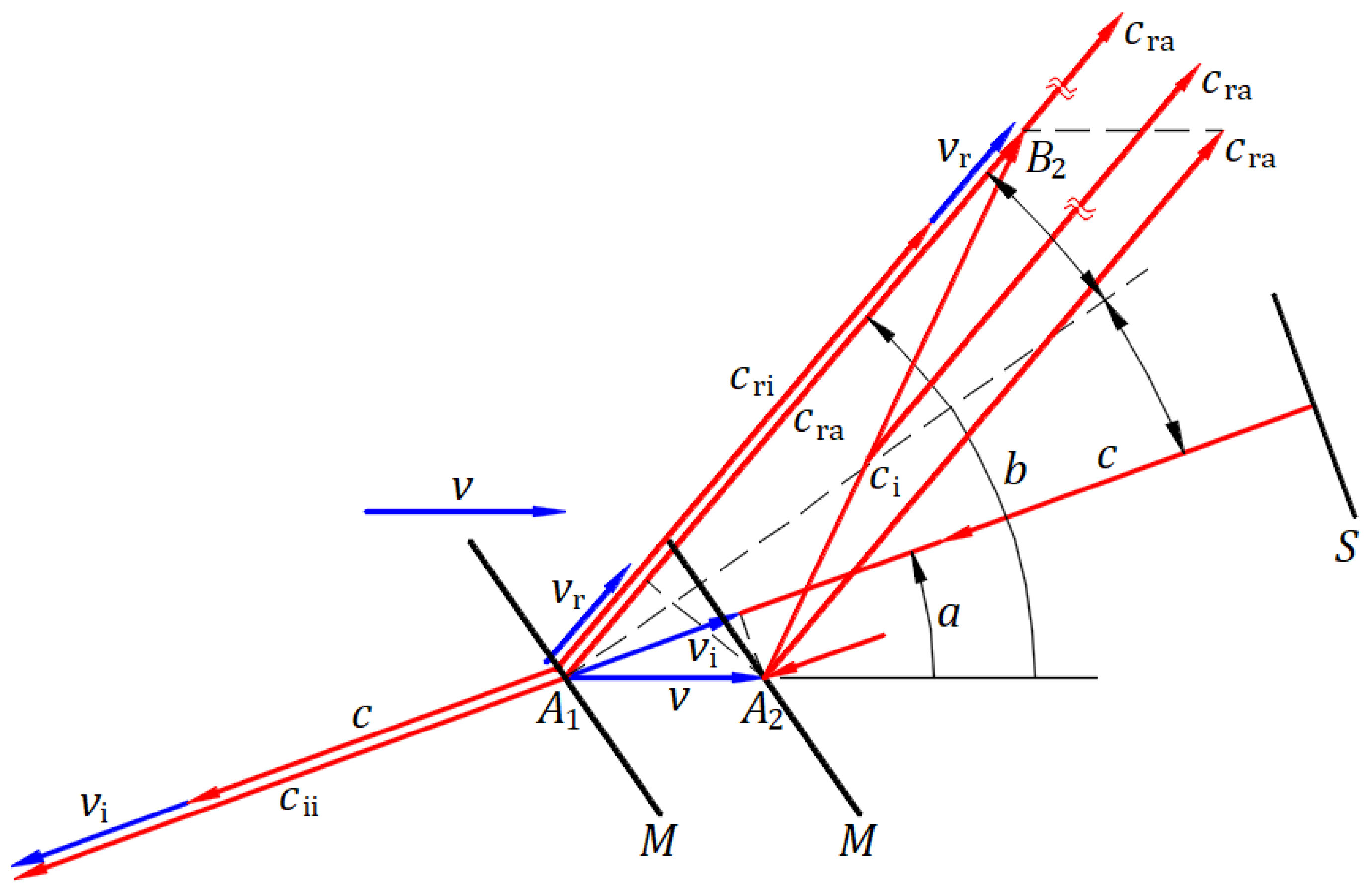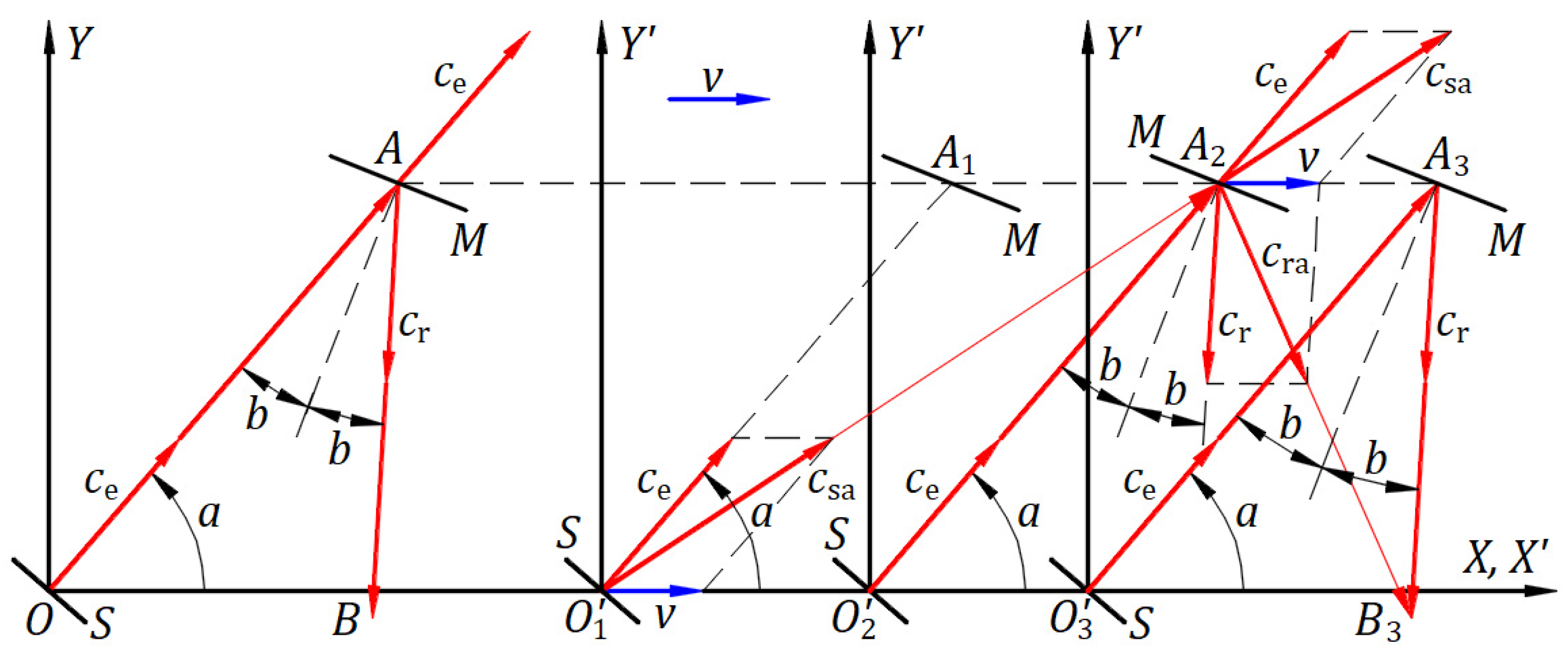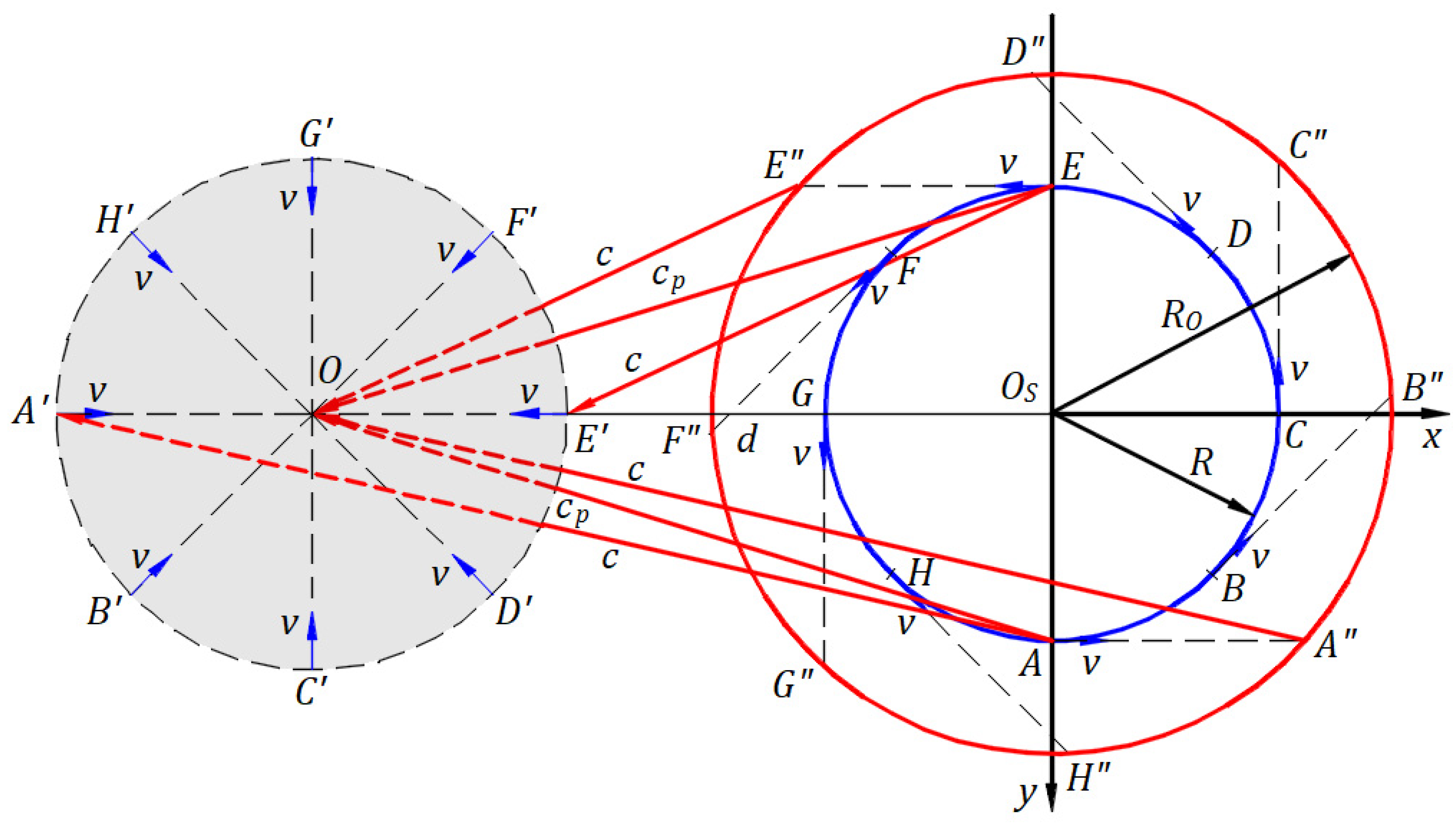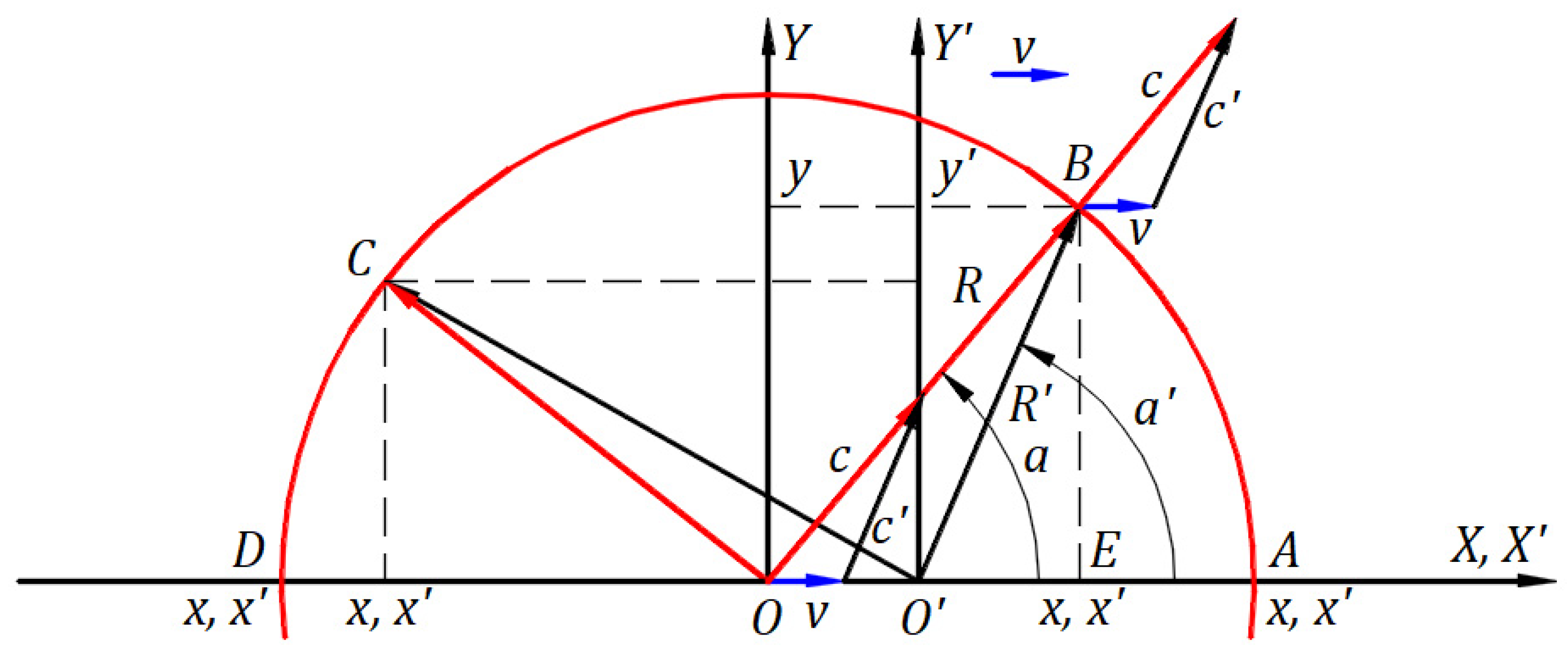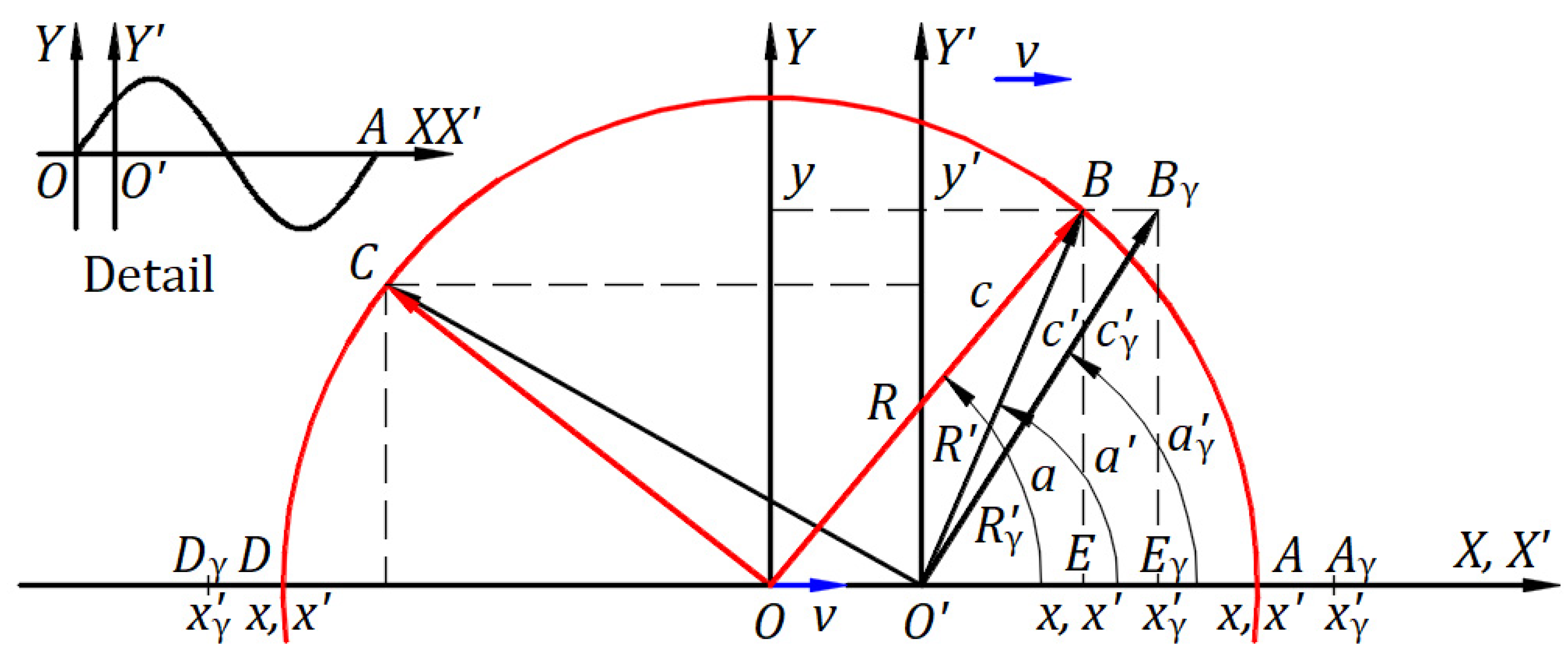4.1. Einstein Suggestions
In the first paragraph on page one of his manuscript “On the electrodynamics of moving bodies,” [
22] Einstein writes the following: “It is known that Maxwell’s electrodynamics—as usually understood at the present time—when applied to moving bodies, leads to asymmetries which do not appear to be inherent in the phenomena. For example, consider the reciprocal electrodynamic action of a magnet and a conductor. The observable phenomenon here depends only on the relative motion of the conductor and magnet, whereas the customary view draws a sharp distinction between the two cases in which either one or the other of these bodies is in motion. If the magnet is in motion and the conductor is at rest, there arises in the neighborhood of the magnet an electric field with a certain definite energy, producing a current at the places where parts of the conductor are situated. However, if the magnet is stationary and the conductor is in motion, no electric field is generated in the neighborhood of the magnet. In the conductor, however, we find an electromotive force, to which in itself there is no corresponding energy, but which gives rise—assuming equality of relative motion in the two cases discussed—to electric currents of the same path and intensity as those produced by the electric forces in the former case.”
Einstein’s example describes a reciprocal experimental observation of a conductor and magnet in proximity when one is in motion/rest and another is at rest/in motion but only when the magnet is in motion an electrical field arises. He may suggest that observations are sufficient to accept reciprocal phenomena symmetrical even if an electromagnetic quantity, such as an electric field, does not occur when the magnet is at rest. Therefore, it is not necessary to rationally understand physical phenomena.
Appendix B shows that in both cases an electric field arises in the conductor, making it an electrical source. Thus, Maxwell’s electrodynamics lead to symmetries when applied to moving bodies; each physical quantity involved in a phenomenon arises and the phenomena can be rationally explained.
Even if the reciprocal phenomena are explained, can we apply the symmetry of phenomena to the symmetry between two inertial frames? Einstein’s example has a magnet and conductor in proximity, and they have reciprocal electromagnetic properties. None of these characteristics applies to a stationary and inertial frame to support special relativity. Origins of the two frames depart from each other and remain nearby for a relatively short time. The frames, including the absolute frame, are hypothetical entities. These tools help us to study and understand physical phenomena. They have no physical properties to transform or duplicate a physical system from one frame to another.
By applying symmetry to two inertial frames, the main idea in special relativity, Einstein unrealistically creates duplicates that lead to irrational conclusions, which are discussed further.
From “Examples of this sort, together with the unsuccessful attempts to discover any motion of the earth relatively to the ‘light medium’,” Einstein concludes with three suggestions in the second paragraph of page 1:
Einstein rejected the idea of absolute rest. However, the inertial frame considered stationary is a local frame at absolute rest for another inertial frame. The stationary frame was a convenient choice to present his transformational understanding of the phenomenon between the two inertial frames.
- 2.
“… the same laws of electrodynamics and optics will be valid for all frames of reference for which the equations of mechanics hold good.”
The equations/laws of mechanics are valid for phenomena belonging to an inertial frame, but not for the coordinates of phenomena in another inertial frame. However, contrary to the second suggestion, special relativity forces the laws of electrodynamics and optics to hold good for coordinate observations, for which mechanics does not.
- 3.
“… light is always propagated in a vacuum with a definite velocity , which is independent of the state of motion of the emitting body.”
In a stationary frame/local frame at absolute rest, the emitted wavefronts from a source at rest at an initial instance travel at the velocity in all directions. The waves wavefronts are on a sphere with the center at the source at all times. However, without considering the ballistic law of light, when the source is in motion at a velocity , the emitted wavefronts at an initial instance travel in the stationary frame at the velocity . In this case, the spherical wavefront has the center at the initial location of the source, which is the origin of the stationary frame, not at the source. Therefore, there are differences in wave propagation if the source belongs to the stationary or inertial frame.
Without understanding the physical phenomena of his example and the comments from the above suggestions, Einstein has chosen to formulate hypotheses based on observations, elevating them to postulates.
4.3. Lorentz Transformation and Einstein Transformation
Figure 10 depicts a stationary frame
in which an inertial frame
travels at a velocity
along the
axis, and the planes
and
coincide. Origins
and
coincide at the initial instance when a light source belonging to the origin
emits a spherical wavefront. After a time
, the spherical wavefront expands in space with a radius of magnitude
, and the origin
is at a distance
from
.
In the theory of the ether at rest in the absolute frame, the speed of light is the constant
. Observations and Michelson‒Morley’s experiment can be explained if the speed of light is the constant
in inertial frames. With no explanation of the Michelson‒Morley experiment during his time, FitzGerald [
24] wrote the following: “I would suggest that almost the only hypothesis that can reconcile this opposition is that the length of material bodies changes, according to their movement through the ether or across it, by an amount depending on the square of the ratio of their velocity to that of light.”
The projection of each coordinate of the spherical wavefront of the stationary frame gives in the inertial frame along the axis
a length
measured from
. Lorentz’s transformation states that light travels a length
at speed
in a time
and consists of four equations that apply to each point of the spherical wavefront as follows:
where
is the Lorentz factor, which is comparable to the square of the ratio of velocity
and
, as suggested by FitzGerald.
Substituting at point , is the absolute coordinate in the inertial frame, and is the hypothetical contracted time by given by Lorentz, in which the wavefront travels length at speed . , , and then , which verifies the constancy of light. Because for , the length is longer than , and point shifts to .
Substituting at point , is the absolute coordinate in the inertial frame, and is the hypothetical dilated time by given by Lorentz, in which the wavefront travels length at speed . , , and then , which verifies the constancy of light. Because for , the length is longer than , and point shifts to .
Lorentz’s transformation makes a duplication but the shift caused by the factor
at points
and
makes the duplication different from the spherical wavefront of the stationary frame, which is not the intention of Lorentz’s transformation or special relativity. The factor
should not be there and can be ignored without affecting the constancy of the speed of light in the two directions of the axis
. Eliminating factor
, the transformation can be written as follows:
In
Figure 10, the mechanical equation for the wavefront traveling the path
is
⇒
⇒
⇒
with
. In Lorentz’s transformation, the equation for
is identical to that in mechanics for
. The terms from the right of the two equations are identical which indicates that
is as well. If we hypothesize that the speed of light is the constant
in any inertial frame, then
from mechanics becomes the speed
and
. Therefore,
offers
⇒
which is the equation of time in Lorentz’s transformation. For clarity, we can employ
instead of
. In the relativistic time of Lorentz’s transformation, the speed of light is the constant
but the time contracts or dilates such that
has the same absolute magnitude as in mechanics; therefore, no length contractions or dilations exist.
The following numerical calculation employs the length
offered by Lorentz’s transformation and all others shown in
Figure 10 that have absolute values. The speed of light along each length
corresponding to each light ray on the axis
is constant
according to the relativistic time in Lorentz’s transformation.
The distance
is the radius
of the circular wavefront in the stationary frame. At time
radius
and for angle
we can calculate
. In triangle
of the inertial frame,
at point
gives
according to Lorentz’s transformation, and employing relativistic speed
along
,
⇒
. The distance
is the variable radius
. The time the light travels along
is equal to the time
the light travels
according to Lorentz’s transformation. Therefore, the speed of light traveling
is
.
Table 1 lists the numerical calculations for the
and
functions of angle
at time
s.
Table 1 confirms that Lorentz’s transformation maintains the constancy of the speed of light for the waves in the direction
and the opposite direction. However, the speed of every other wave direction varies converging to infinite. The second postulate asserts the constancy of the speed of light in the inertial frame regardless of its direction; whereas the transformation drastically concludes otherwise.
4.4. Discussions
1. Is it rational to observe the circular wavefront with its center at the origin and to keep the speed of light constant along the axis in both directions or to have a theory that may or may not explain experiments and observations without understanding their physics phenomena? Furthermore, is it reasonable to force the circular wavefront and its observations to follow the same physical laws as those in the stationary frame? Einstein chose this approach, leading to an irrational world. Unlike special relativity, Newtonian laws present phenomena as they are, rationally understood by themselves, and not accepted by observations, hypotheses, or postulates.
2. What natural phenomena can transform each wave from a stationary frame into its unique form, as required by Lorentz’s transformation and shown in
Figure 10? Other mathematical transformations can be considered, e.g., ignoring the Lorentz factor
as discussed in
Section 4.3, allowing the speed of light to be constant along each wave in the inertial frame, or having the time a constant and the speed of light variable according to its direction [
25]. Could there be a phenomenon for each of these hypothetical mathematical transformations to explain the Michelson‒Morley experiment? If so, which one would be correct? If we attempt these transformations, we obtain a theory with irrational conclusions like that for special relativity.
3. A ruler identical to that in the stationary frame is required to measure the lengths involved in phenomena that belong to the inertial frame. We also must have two rulers with different scales required by Lorentz’s transformation to measure the lengths along according to positive or negative without considering other directions. The use of multiple rulers is unacceptable. The same conclusion applies to multiple synchronized clocks.
4. Suppose that the inertial frame also has a source at its origin. When the origins coincide, each source emits a circular wavefront of light. Considering factor , imagine the confusion in the inertial frames having two different wavefronts, one of its own and another observed from the stationary frame.
5. When we observe a star that involves astronomical distances, as seen in the example in
Section 3.4.4, we observe it in an enlarged orbit without irregularities; however, our observation does not change the actual orbit. There is no need to mention other observations close to our eyes that we know are not factual. These observations can be explained by laws of physics. However, we must distinguish between actual phenomena and their local observation. Therefore, we cannot rely solely on observations. Special relativity focuses on observations but makes no distinction between the emitted and propagated velocities of waves’ wavefronts. It fails to consider that our eyes perceive only the direction of waves emitted by a source and reflected by a mirror, not the direction of wave propagation.
6.
Figure 10 illustrates a case in which origins
and
coincide at the initial instance. However, origin
may be far away from
when the source emits a spherical wavefront at an initial instance. In this case, there is an interval of time when the circular wavefront does not include the origin
, a time when the circular wavefront is at the origin
, and an interval of time converging to infinite when the circular wavefront includes the origin
. How is the circular wavefront observed at
at these different times? Do we force the coordinates of the circular wavefront to be observed according to the Lorentz transformation with its center at
at any time?
7. Suppose that a source of balls in the stationary frame emits balls of equal mass in all directions at a speed
that is higher than the speed of the inertial frame
. As for light, the coordinates of the spherical ball front in the inertial frame at a time
are as in
Figure 9. Mechanics does not and cannot force the coordinates of the circular ball front to have its center at
; in Einstein’s words, “the equations of mechanics do not hold good” in this case. However, special relativity does not respect Suggestion 2 in
Section 4.1.
8. The first postulate indicates that the physical systems in the stationary frame change when they are transformed/duplicated into the inertial frame. The physical system mentioned in the first postulate has a source and light rays that create a circular wavefront. However, other systems may contain bodies and living beings involved in a phenomenon. Considering that the origin of inertial frames is relative, their origins can be at the origin of the stationary frame when the source emits a spherical wavefront of light. We can imagine what the physical systems’ duplication from a stationary frame in all other inertial frames means. Moreover, each inertial frame may be arbitrarily stationary; therefore, a phenomenon from another stationary frame can be duplicated in all other inertial frames. Do all these duplications occur just by choosing a stationary frame? All these duplications are irrational and are not observed in the universe or at a local scale.
9. In a stationary frame, as shown in
Figure 10, the origin
of the inertial frame may travel through a few consecutive points along the
axis. Suppose that a phenomenon arises in the stationary frame when the origin
coincides with each consecutive point. Each of these phenomena is thus transformed at the origin
. Imagine all of these phenomena involving bodies and living beings at
.
10. In
Figure 10, when the origins coincide, the light source emits in the stationary frame waves in all directions at speed
, with wavelength λ, period
, and frequency
that are not disturbed by the inertial frame in which the wave propagation is observed. When the wavefront that travels along the
axis arrives at point
in time
, the length
is given by equation
⇒
⇒
. The equation
can be rewritten as
⇒
where
,
, and
are the numbers of wavelengths comprised in the lengths
,
, and
. For
,
is a fractional relation of a rational number
. The number of wavelengths
can be replaced with
which may mean one wavelength or the length
as in the Detail of
Figure 10 which gives
, or the length
which yields
, or the speed
which offers
. As fractional relations, all these arrangements are correct and meaningful in mechanics.
When we replace
with the time
, the fractional relation
is susceptible to relativistic time interpretation. The fractional term
yields
, the equation for time
in the set of Equations (10) of Lorentz’s transformation. As shown in detail in
Figure 10, light travels the fraction
of wavelength
in time
. This implies that, in the inertial frame, light travels one wavelength
at period
⇒
, frequency
, and speed
, as in the stationary frame. Considering
and
as in mechanics, the set of Equations (10) of Lorentz’s transformation is complete, which gives in the inertial frame absolute length
,
,
, and fractional time
, as in
Section 4.3. We presented a mechanical derivation of Lorentz’s transformation identical to the hypothesized Lorentz transformation as in
Section 4.3. Understanding the incorrectness introduced in this derivation, we know that of Lorentz’s.
We obtained the division of
for the wavefront in the direction
as in
Section 4.3 where incorrectly considered it to verify Lorentz’s transformation. Here, the speed
does not represent the speed of light in the inertial frame as Lorentz’s transformation and Einstein’s special relativity pretend because the equation
is correctly a relation between different quantities that gives an absolute length but the term
belongs to
that is a fractional relation for a quantity, which in this case is time
. Indeed, the division can be written as
⇒
⇒
as in mechanics with variable speed
according to the speed of the inertial frame. This incorrectness in Lorentz’s transformation and Einstein’s special relativity not only refutes them but proves the constancy of time passage in the universe and the variability of light speed in the form of light propagation; light emitted by a source in motion is the constant
in the absolute frame.
The following paragraphs show how different the Doppler observation in an inertial frame is from special relativity.
As shown in detail in
Figure 10, light travels the fraction
of wavelength
in time
. This means that, in the inertial frame, light travels one wavelength
at period
, speed
, and frequency
that is the observed frequency offered by the Doppler effect. The number of wavelengths
comprising
is
.
In the direction, light travels the length in time and one wavelength at period , speed , and frequency that is the observed frequency offered by the Doppler effect. The number of wavelengths comprising is .
